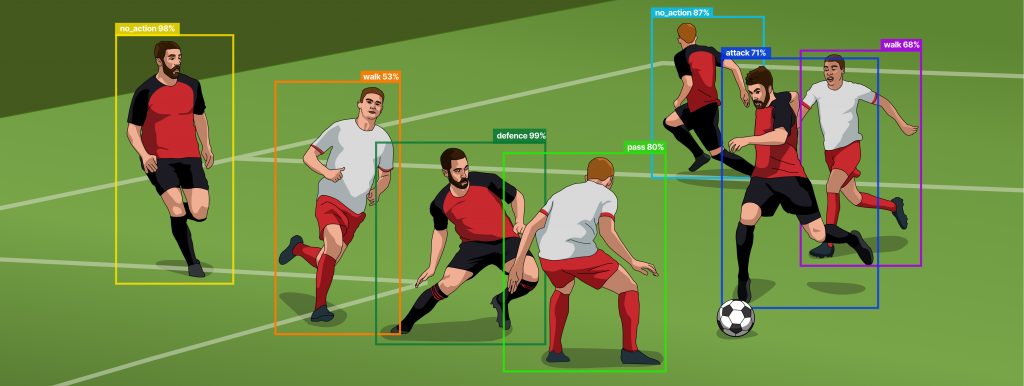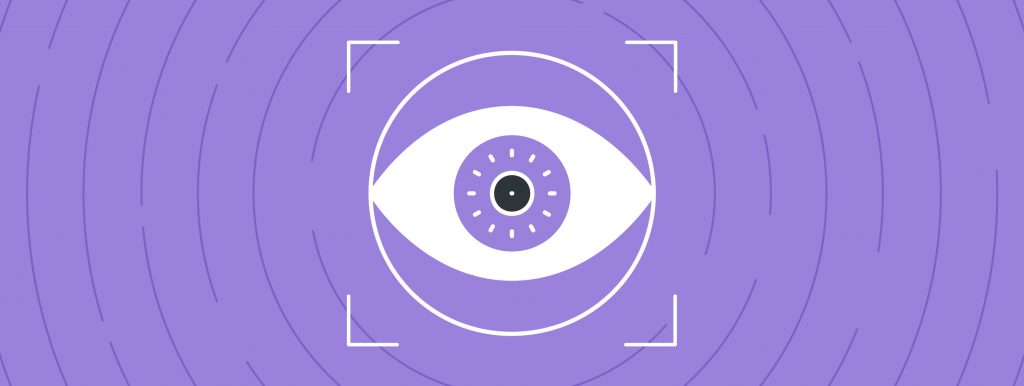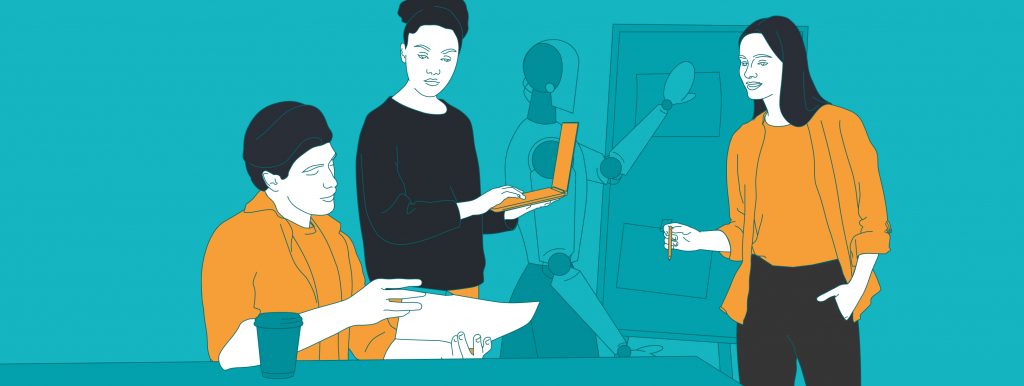It is no secret that Artificial Intelligence (AI) remains one of the main trends in digital transformation for several years. AI is no longer just a favorite topic of tech geeks; it frequently appears in the news, small-talking, and even during phone conversations with your grandmother.
Today one of the main fast-moving trends in AI that shows great potential in many different industries is Computer Vision (CV). If you are still not familiar with CV, it can become a grave shortcoming, because CV allows you to learn, see and understand more than your competitors and turn you into an industry trend-setter. Sounds great, isn’t it?
In this article, together with Kirill Lozovoi, Head of AI Business Unit at Exposit, we will tell you all in order: what is actually Computer Vision, capabilities it provides, and how you can benefit from implementing this smart technology into your business.
Computer Vision overview
In the world of Artificial Intelligence, many terms remain not clear for an ordinary man. People often confuse Machine Learning with Deep Learning, try to understand the difference between neural networks and smart algorithms, and debate which terms have a broader sense.
The same happens when people try to find the right place for Computer Vision in AI. Well, let’s clear that up. Computer Vision or CV is a field of Artificial Intelligence related to image and video analysis. It involves a set of methods for making a computer see more and extract data from what it has seen.
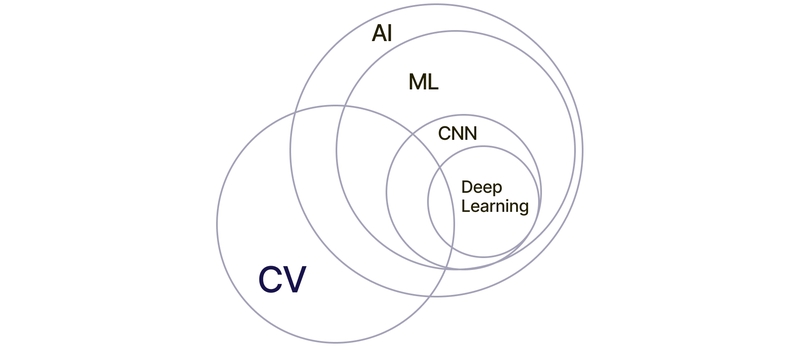
How does it work? Every image consists of pixels, the smallest units of information that are used by Computer Vision algorithms to identify patterns and extract valuable data. Each pixel you see on the screen is represented by 8 bits of memory or 8 numbers (e.g., 10100011), each color is represented by a value.
Thanks to breaking images into the smallest pieces with a unique value, you can automate your data analysis and get operational insights for your business in real time. It’s like magic, but computer science.
One more important thing you need to understand is that to identify any pattern and provide a quality outcome, a Computer Vision model should know and understand it clearly. It is achieved by model training. So, whatever your algorithm is used for – image recognition, object tracking, matchmaking, or deep analysis, it needs the right data to learn and memorize.
Usually, a model needs as much data to train as possible: you can never have too much. The more data you have, the more advanced model you can develop to address your business goals.
Then, when there is enough amount of related data, Data Engineers come into play to clean it for modeling: they create datasets, excluding data that doesn’t bring any value. And after all preparations, here we are: a model is ready for training and performance evaluation.
Now, when you have learned the basic concept of Computer Vision, we can move on to the exploration of Computer Vision capabilities.
Introduction to the key Computer Vision capabilities
Computer Vision technology provides various capabilities for getting different outcomes. These capabilities are also often described as Computer Vision tasks. Depending on your needs, you may need a single capability or a combination of capabilities required to achieve your goals: no worries, a professional team can easily identify what is your “perfect match”.
Most of the CV tasks are aimed at process automation, however, some of its capabilities can never be successfully undertaken by a human. Let’s explore key CV capabilities in more detail:
- Object detection
Computer Vision object detection refers to detecting instances of objects of a certain class within an image. So, in other words, it allows you to detect, classify, and count a variable number of objects in real time. Object detection is often used to improve security and safety for responding to an emergency: detecting prohibited items at the airport, helmets on the heads of construction workers, or whatever you need.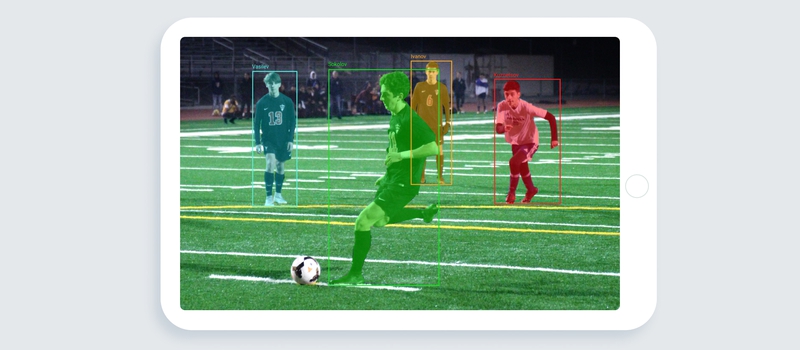
- Object identification
Object identification is the process of identifying someone or something by unique characteristics. It helps to distinguish one object from another: people have different faces, cows have different skin patterns, whales have different patterns on their tails, and so on. The most familiar case is probably face recognition. - Object tracking
Object tracking in Computer Vision refers to taking an initial set of object detections with unique IDs and then tracking each object as they move around frames in a video, maintaining the ID assignment. And all that is possible in real time. Let’s say you want to track the movement of customers in your store and get the outcome in the form of the heat maps, identifying the most passable areas. This task can be undertaken by object tracking. - Event detection
Event detection is aimed at detecting the occurrences of events and categorizing them. It can help you to better understand the context of real-world scenarios. This approach is popular in sports: for example, you can control the execution of physical exercises or detect events like pass, foul, etc. on the playground. Event detection is also often used for advanced safety and security solutions. - Image classification
Image classification is the process of labeling and categorizing groups of pixels or vectors within an image based on specific rules. It can work with a simple condition of whether an image contains a particular object or not or divide images into multiple categories according to the specified criteria.For example, social media companies want to automatically identify and segregate images uploaded by users. Or, specialists want to identify different areas by type of land use for informed urban planning. It is all about image classification. - Object classification
Computer Vision object classification is the process of dividing images and objects into typical broad categories. For example, you may need to sort goods on the conveyor line (by ripeness, size, etc.) or detect an unrecognized object to notify about the violation. - Object Character Recognition (OCR)
OCR is focused on distinguishing printed or handwritten text characters inside digital images of physical documents. In other words, it allows you to convert any kind of text into a digital format making data searchable and easy to process. OCR can be applied in various industries: you can extract data from checks and signatures in the financial sector or scan X-rays and medical records in healthcare. - Scene reconstruction
Scene reconstruction is the process of creating a 3D model of a scene inputted through images or video to embed objects in an image, taking into account their size. This way, you can experience context simulations and test your ideas. For example, fitting a vase to your photo.

- Visual data analytics
Computer Vision allows you to not just collect data from various visual sources, but also analyze it and make smart recommendations for decisions. Here works the decision-to-be-made concept.
So, we figured out the technical part and can move on to the business part. What benefits can Computer Vision solutions bring to the business?
Computer Vision solutions: values for business
Software solutions with Computer Vision capabilities can bring companies and decision-makers great benefits in various industries: from Healthcare to Farming. You can cut costs and reputation losses, increase revenue, optimize processes, increase market share, and more.
Our team identifies main values that businesses can get from the implementation of a Computer Vision solution as:
- Risk reduction
Implementation of Computer Vision can help you effectively manage risks and contribute to a safe working environment and transparent internal processes. This way, you can avoid additional spendings and reputation losses, ensuring the highest level of service.For example, you can easily control the observance of safety techniques in the workplace: wearing personal protective equipment (helmets, goggles, etc.), being in the danger zone (rooms with radiation, high temperature, etc.), identifying non-standard behavior in the workplace. - Customer experience
Computer Vision helps you better understand your clients: their behavior, preferences, and needs. Thanks to enhanced understanding, you can provide them with more personalized service increasing engagement and loyalty.CV solutions also perform well in reputation management. Imagine that you ship a defective product to your buyer: in this case, sooner or later, you will not only lose your client but also get anti-advertisement for your company. However, if you determine goods of inadequate quality at the packaging stage, you will preserve your reputation. - Bottlenecks reveal
Computer Vision-driven process monitoring positively impacts operational efficiency. Collecting and analyzing process-related visual data can help you discover and improve bottlenecks in your processes.For example, collecting data on each worker’s throughput allows making recommendations on the need for an extra worker in a particular area. This approach allows you to make accurate, on-time decisions and, therefore, optimize production or any other internal process. - Market strategy improvement
The use of advanced technology is a significant factor in market competition. Customers tend to be more loyal to a car manufacturer using robotic conveyors than to a one that does not. That is how marketing works.The adoption of computer vision systems is a good way to gain a competitive advantage over your rivals and empower your value proposition. In turn, it can help you increase your market share and reach new audiences. - Expertise reusing
Implementation of a Computer Vision solution contributes to economies of scale. Finding highly skilled and efficient employees is challenging for a business and can often slow down its development.
Computer vision solutions, in turn, can automate most tasks delivering more accurate results and keeping you and your team focused on your core business. For example, how many fields can control a good agronomist to guarantee a rich harvest? Computer vision systems can do it 24/7 in any number of fields.
Computer Vision service by Exposit
For the last couple of years, we have been accumulating experience in business and technology to provide you with a highly professional Computer Vision service ready to address your biggest challenges and enhance your business potential.
We provide innovative services by integrating computer vision capabilities of detecting, identifying, classifying, and monitoring events and objects to extract statistical data and generate AI-powered operational insights to address the business goals of diverse industries.
Contact us if you are interested in getting more information or brainstorming your business challenge with our expert team. And remember, the one who knows more stands out in data-driven business world.




